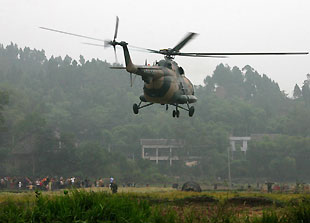CHENGDU: China's seed-breeding satellite, Shijian-8, successfully landed in
Sichuan Province, Southwest China, at 10:43 am Beijing time yesterday after a
15-day flight in space.

Helicopter
carries the return capsule off the ground in Suining, Southwest
Sichuan Province on September 24, 2006.
[Xinhua] |
The recoverable satellite was launched
from the Jiuquan Satellite Launch Centre in Northwest China on September 9.
The satellite's return capsule was recovered in Suining, Sichuan Province.
The orbital module will continue to orbit the earth and carry out more
experiments until its battery runs out.
The satellite carried 215 kilograms of seeds of vegetables, fruits, grains
and cotton, the largest load of this kind since 1987.
Scientists from the Space-breeding Centre of the Chinese Academy of
Agricultural Science used the mission to carry out experiments aimed at
discovering what happens to the germination and sprouting of plants when they
are exposed to zero gravity.
After being exposed to cosmic radiation and zero gravity, some seeds may
mutate and produce higher yields and improved quality when planted back on
earth, scientists said.
During its flight, the satellite sent back high-definition digital images of
sprouting vegetables, according to the Institute of Plant Physiology &
Ecology with the Shanghai Institute for Biological Sciences under the Chinese
Academy of Sciences, which is conducting the experiment.
An official from the Ministry of Agriculture said the ministry will ask
research institutes to use the seeds returned from space to develop new strands
featuring high yields, good quality and high efficiency.
Since 1987, China has carried out seed breeding tests on nine satellites and
a number of new species of plant seeds have been bred in space by Chinese
scientists.
Over the past four years, new types of crop developed with space-bred seeds
have been planted in a total of 567,000 hectares of farmland, producing 340
million kilograms of grain and direct GDP of 500 million yuan (US$62.5 million).
The United States and Russia are also capable of breeding seeds in space.
The Shijian-8 is the 90th space flight made by Long March rockets and the
23rd time China has launched a recoverable satellite. China has chalked up 48
successful space launches in a row since October 1996.